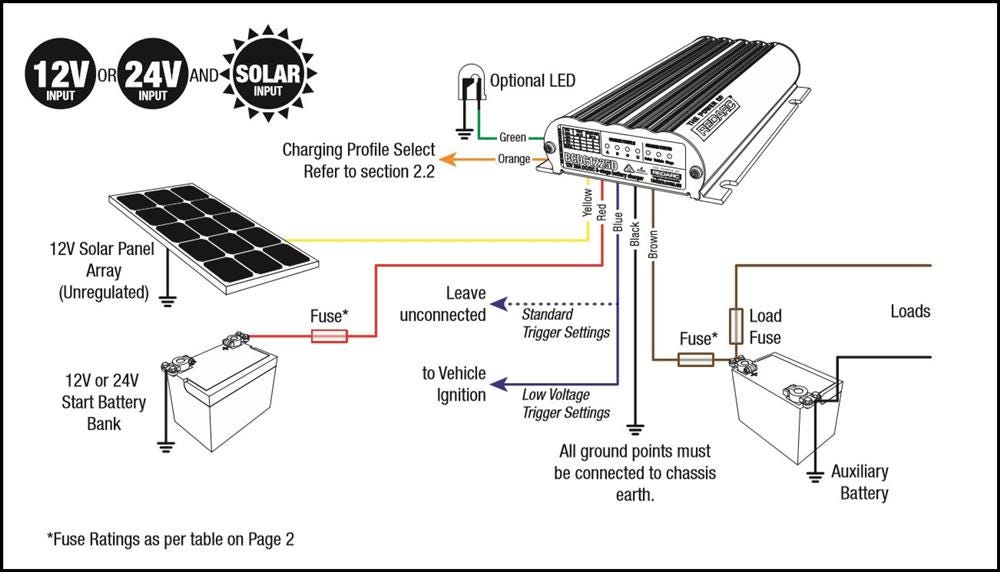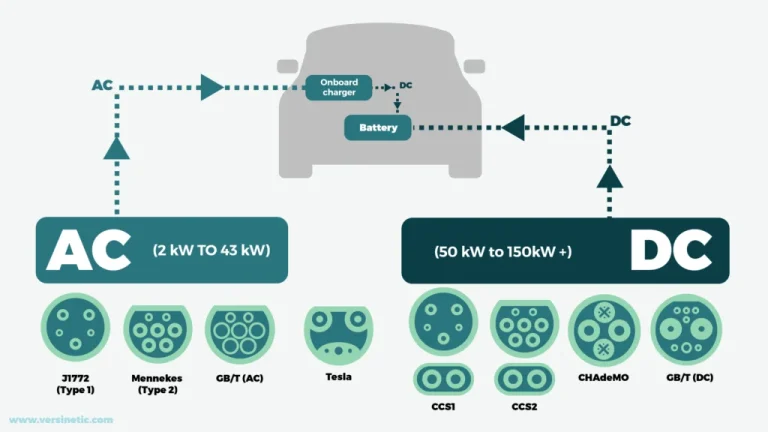The Dc to Dc charger wiring diagram helps to visualize the installation process for connecting a Dc to Dc charger to a power source and the battery. This diagram typically includes the layout of the components, the wiring connections, and the necessary electrical specifications.
By following the wiring diagram, users can ensure proper installation and safer operation of the Dc to Dc charger. When setting up a Dc to Dc charger, it’s essential to understand the wiring diagram to ensure correct connections and operation.
Dc to Dc charger wiring diagram
With clear visuals and instructions, the diagram facilitates a smooth installation process, making it easier for users to harness the full potential of their Dc to Dc charger. Let’s explore the key components and connections typically depicted in a Dc to Dc charger wiring diagram, providing a comprehensive understanding of the setup process.

Credit: www.digikey.com
Components Of A Dc To Dc Charger
A DC to DC charger is an essential component of a reliable power system for off-grid or mobile setups. It efficiently converts power from one DC voltage to another while ensuring maximum efficiency and safety. Understanding the components of a DC to DC charger is crucial for proper installation and operation.
Dc to Dc charger wiring diagram
Solar Panels
Solar panels are the primary source of power in a DC to DC charging system. They convert sunlight into electricity using photovoltaic cells. The generated electricity is then stored in the battery bank for later use. Understanding the wattage and voltage of your solar panels is crucial for determining the optimal sizing of the DC to DC charger.
Battery Bank
The battery bank stores the electricity generated by the solar panels. It provides a steady power supply when the solar panels are not producing power. Proper sizing and maintenance of the battery bank are essential for the overall performance and longevity of the DC to DC charger system.
Dc To Dc Charger Unit
The DC to DC charger unit is the central component that regulates the flow of electricity from the solar panels to the battery bank. It ensures that the battery bank is charged optimally and safeguards against overcharging or undercharging. The DC to DC charger unit also plays a crucial role in maximizing the efficiency of the entire charging system.
Wiring The Dc To Dc Charger
When it comes to wiring the DC to DC charger, there are a few key steps you need to follow to ensure a successful installation. In this section, we will cover connecting the solar panels, linking the battery bank, and the installation of the DC to DC charger unit. Let’s dive in and get started!
Dc to Dc charger wiring diagram
Connecting The Solar Panels
The first step in wiring your DC to DC charger is connecting the solar panels. Here’s a simple breakdown of how to do this:
- Start by positioning the solar panels in a location where they will receive maximum sunlight throughout the day. This will help to ensure optimal charging efficiency.
- Connect the solar panel output cables to a junction box. This box will act as a central connection point for all the solar panels.
- From the junction box, run a cable to the DC to DC charger unit. Make sure to use an appropriately sized cable that can handle the voltage and current of the solar panels.
- Connect the solar panel cable to the designated input terminals on the DC to DC charger unit. Follow the manufacturer’s specifications for proper connection.
Linking The Battery Bank
Next, it’s time to link the battery bank to the DC to DC charger. Here’s how you can do it:
- Locate the battery bank and ensure that it is in a well-ventilated area. Battery safety is key, so make sure there is no risk of overheating or exposure to extreme temperatures.
- Measure the distance between the battery bank and the DC to DC charger unit, and cut a cable of the appropriate length.
- Connect one end of the cable to the positive terminal of the battery bank and the other end to the positive input terminal of the DC to DC charger unit.
- Repeat the process for the negative terminals, ensuring you connect the cable from the negative terminal of the battery bank to the negative input terminal of the DC to DC charger unit.
Installation Of The Dc To Dc Charger Unit
Now that the solar panels and battery bank are connected, it’s time to install the DC to DC charger unit. Follow these steps:
- Choose an appropriate location for the DC to DC charger unit near the battery bank and solar panels. Ensure that it is easily accessible for maintenance and monitoring.
- Securely mount the DC to DC charger unit using appropriate brackets or screws, following the manufacturer’s instructions.
- Connect the solar panel cables and battery bank cables to the corresponding input terminals on the DC to DC charger unit.
- Tighten all the connections to ensure a snug fit and minimize the risk of loose connections.
Dc to Dc charger wiring diagram
And there you have it! By following these simple steps, you can successfully wire your DC to DC charger. Remember to always follow manufacturer guidelines and specifications for your specific charger model to ensure a safe and efficient installation.
Charging System Optimization
Efficient Power Flow
Maximizing power flow efficiency is crucial for an effective charging system in a DC to DC charger wiring diagram. To ensure the most efficient power transfer, it is important to minimize resistance and voltage drops along the charging path. Use high-quality wiring and connectors to reduce the resistance and ensure a smooth flow of electricity. Adequate wire gauge size, appropriate for the current being carried, is essential for efficient power flow.
Dc to Dc charger wiring diagram
Additionally, proper grounding is essential to ensure effective power flow. Grounding provides a return path for the flow of electricity, minimizing voltage drops and optimizing charging efficiency. It is crucial to check for a secure and corrosion-free grounding connection to avoid any disruptions in power flow.
Maintenance And Safety Considerations
Regular maintenance is essential to optimize the charging system’s performance and ensure its longevity. Periodically inspect all wiring connections to identify any signs of wear, damage, or loose connections. Address any issues promptly to prevent further damage and maintain optimal power flow.
Dc to Dc charger wiring diagram
Safety precautions should also be a primary concern when working with a DC to DC charger wiring diagram. Follow industry-standard safety practices to reduce the risk of electrical accidents or fire hazards. These include using appropriate safety gear, such as insulated gloves and goggles, when working on the charging system and keeping the area clean and free from flammable materials.
Always refer to the manufacturer’s instructions and guidelines for proper installation and operation of the charging system. If you are unsure or inexperienced in working with electrical systems, it is recommended to seek professional assistance to ensure safety and proper functioning of the charging system.

Dc to Dc charger wiring diagram

Dc to Dc charger wiring diagram
Frequently Asked Questions Of Dc To Dc Charger Wiring Diagram
Can I Install A Dc To Dc Charger In My Vehicle?
Yes, you can install a DC to DC charger in your vehicle. A DC to DC charger allows you to efficiently charge your auxiliary battery from your vehicle’s main battery while on the go. It is a great option for off-road vehicles or those with extra power requirements.
How Does A Dc To Dc Charger Work?
A DC to DC charger works by taking the voltage from your vehicle’s main battery and converting it to a higher or lower voltage to charge the auxiliary battery. It ensures that both batteries receive proper charging levels, maximizing their performance and lifespan.
What Are The Benefits Of Using A Dc To Dc Charger?
Using a DC to DC charger has several benefits. It allows you to charge your auxiliary battery without the need for external power sources, which is ideal for camping or off-grid adventures. It also ensures that the charging process is efficient and optimized, preventing damage to your batteries.
Can I Install A Dc To Dc Charger Myself?
While it is possible to install a DC to DC charger yourself, it is recommended to seek professional assistance, especially if you are not familiar with electrical systems. Hiring a qualified technician will ensure that the installation is done correctly and safely.
Conclusion
To sum up, mastering the wiring diagram for a DC to DC charger is crucial for ensuring efficient and reliable power supply in various applications. By following the correct wiring instructions, you can maximize the charging efficiency and protect your devices from potential risks.
Remember to pay close attention to the polarity, fuse rating, and appropriate wire size to guarantee optimal performance. With this essential knowledge, you can confidently customize your power system and enjoy a seamless charging experience.
🔋 Welcome! I’m Faiyaz Sumon, your guide to all things batteries! From researching innovations to finding the safest options, my curiosity drives me to uncover their full potential.⚡️Delving into lithium-ion, nickel-metal hydride, and more, I’m on a mission to find the best batteries for every need. From gadgets to electric vehicles, the right battery can transform our lives.♻️Beyond finding top batteries, I’m passionate about responsible disposal and recycling. Let’s minimize environmental impact and maximize battery longevity together!🔍As a perpetual learner, I share insights on battery tech, safety, and recycling through my blogs. Join me as we power a more sustainable future!


